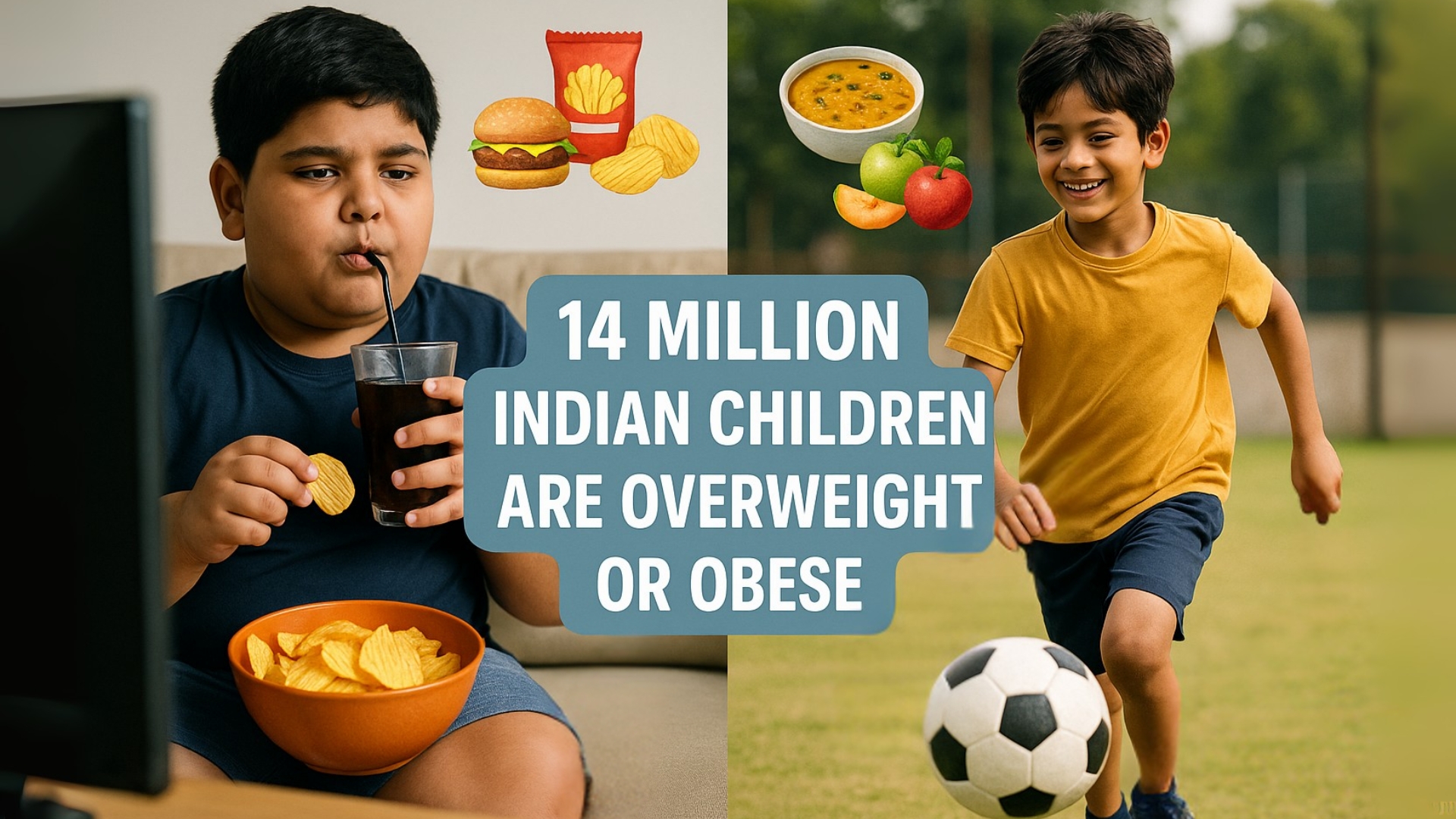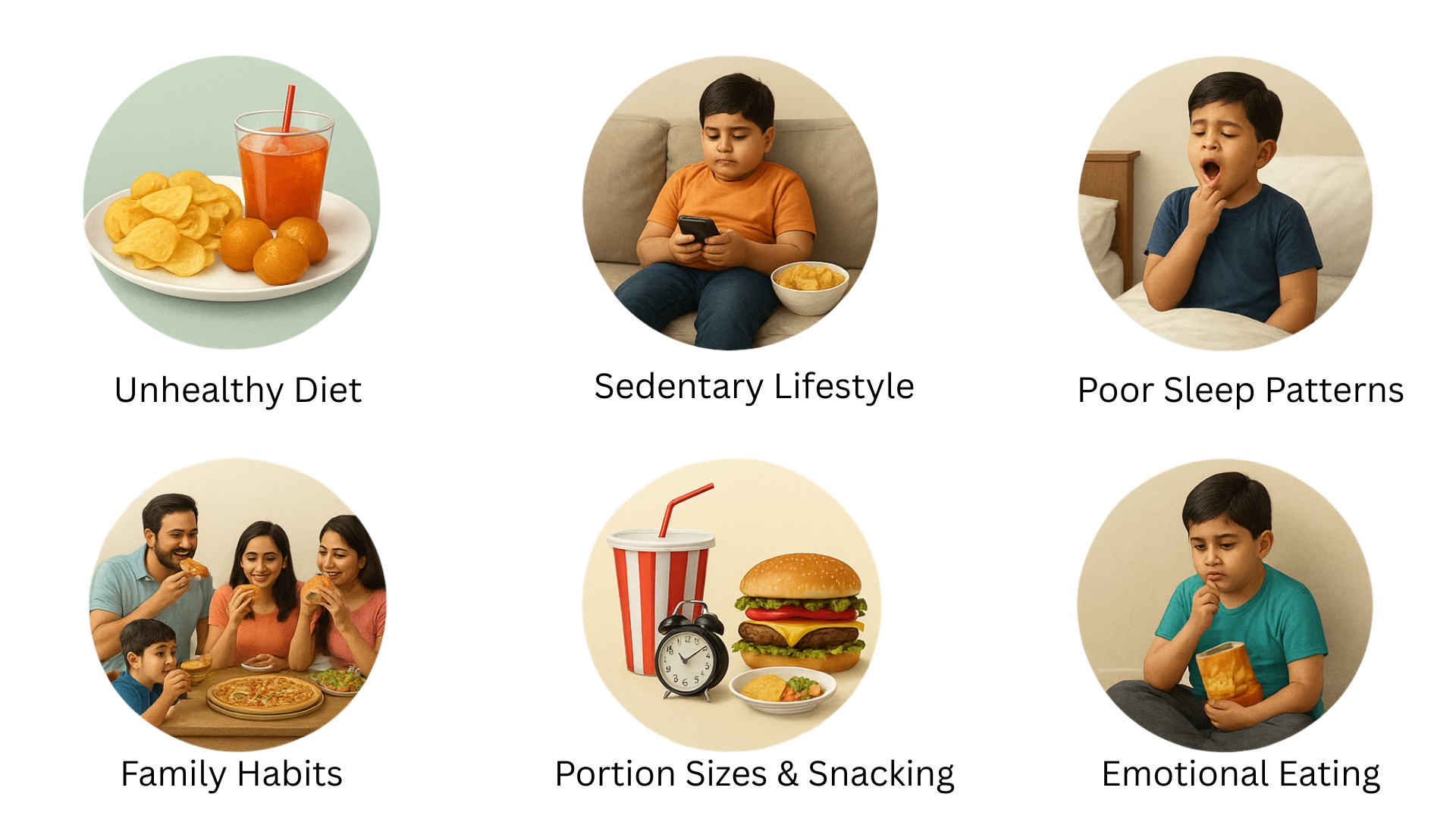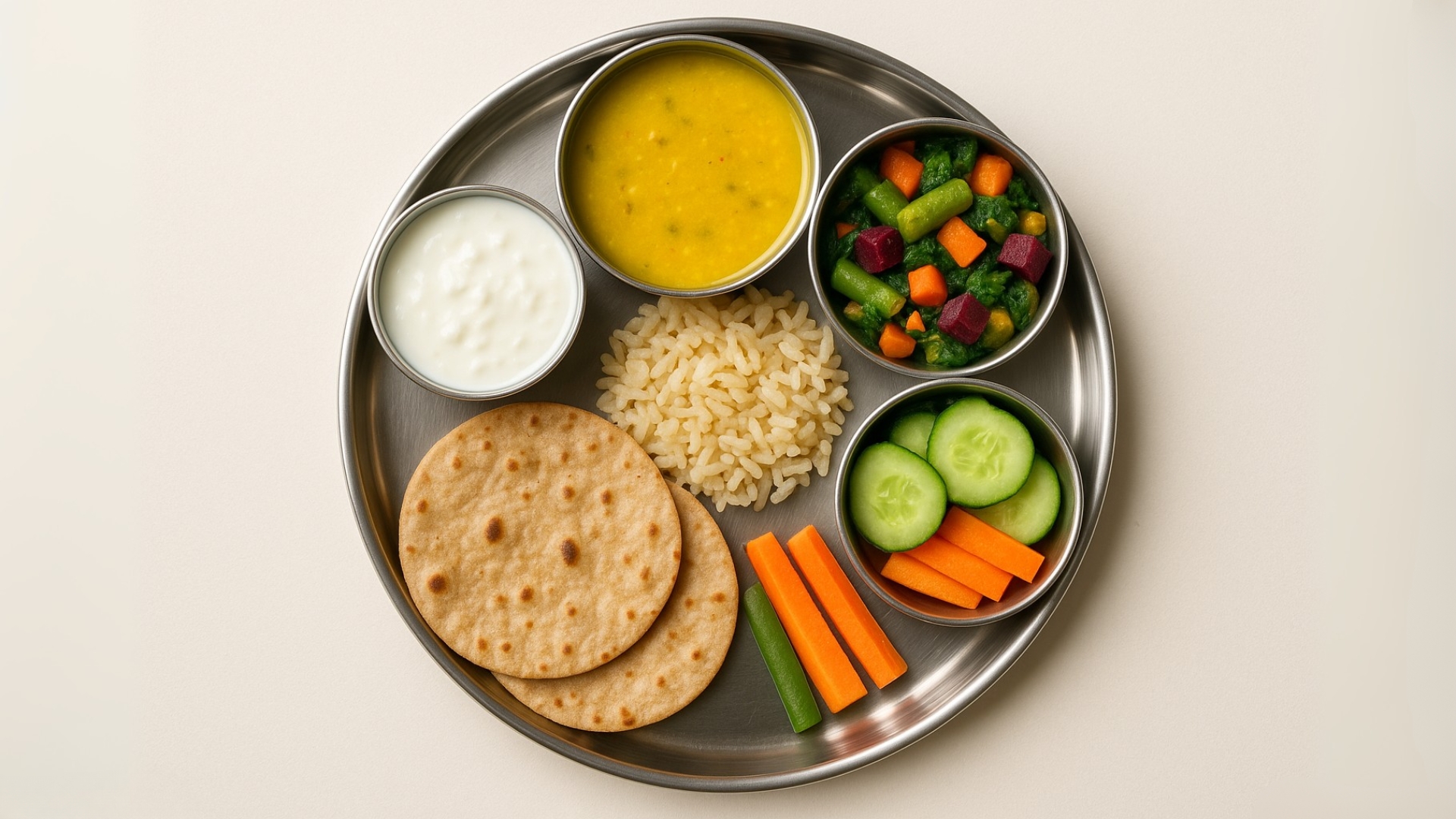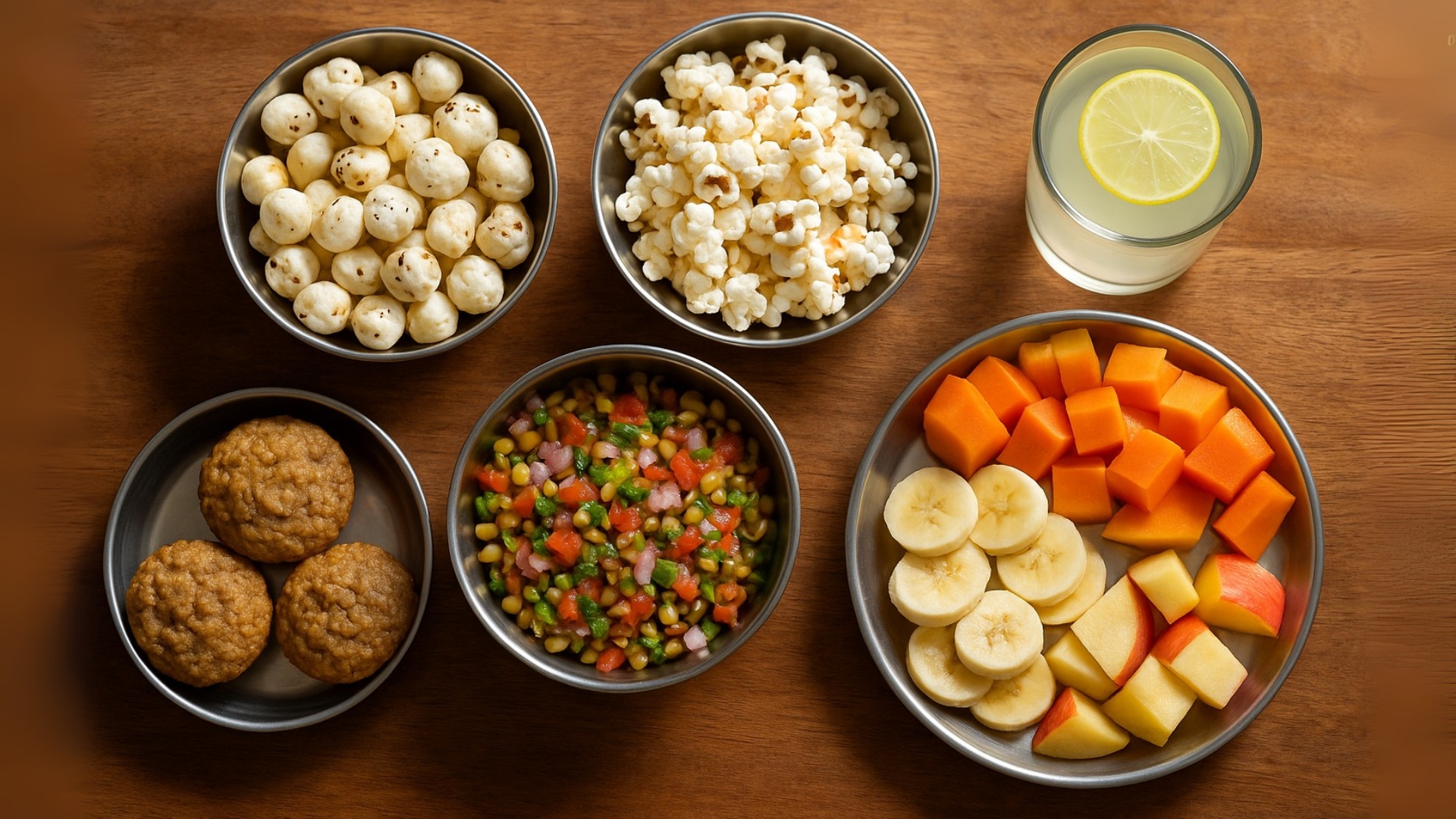Did you know that approximately 14 million children in India are overweight or obese? Yes, you read that right — childhood obesity has become a serious problem in recent years, not just in urban areas, but increasingly in smaller towns and rural regions too. As lifestyles become more sedentary and processed foods replace traditional meals, childhood obesity is on the rise, posing a growing concern for Indian families.

The causes and effects of childhood obesity go beyond physical appearance. It significantly increases the risk of early-onset diabetes, high blood pressure, joint pain, and emotional challenges such as low self-esteem and social isolation. More alarmingly, these effects often continue into adulthood, creating long-term health implications. Understanding childhood nutrition and obesity is now more important than ever for Indian parents.
But here’s the good news: With the right knowledge, habits, and support, you can prevent childhood obesity and ensure your child lives a healthier, more active life. In this blog, we’ll explore practical and culturally-relevant strategies — from designing a balanced sample diet plan to encouraging exercise routines that actually work for your family. You’ll also learn about realistic diet plan for childhood obesity, how to recognize unhealthy patterns early, and simple ways to prevent it starting today.
So whether you’re a worried parent or just trying to make better choices for your child, this blog is for you. Let’s take the first step toward building healthier habits — one meal and one moment at a time.
Understanding Childhood Obesity
In today’s fast-paced and technology-driven world, childhood obesity is no longer a rare condition. It refers to a situation where a child has excess body fat that negatively impacts their health and well-being. Unlike the occasional weight gain that can come with growth periods, childhood obesity has become a serious problem in recent years, especially in India, where traditional diets are rapidly being replaced by processed, calorie-dense foods.
When left unaddressed, the effects of childhood obesity can extend far beyond appearance — impacting both physical and mental health, and often continuing into adulthood. The best part? It’s preventable. With awareness and timely intervention, families can take meaningful steps to prevent childhood obesity and help children lead happier, healthier lives.

Causes of Childhood Obesity
Understanding the root causes is the first step to change. Some of the primary causes of childhood obesity include:
Unhealthy Diet:
Frequent consumption of high-calorie, low-nutrient foods like chips, sweets, sugary drinks, and fast food.
Sedentary Lifestyle:
Lack of regular physical activity and excessive screen time — TV, video games, mobile phones.
Poor Sleep Patterns:
Inadequate or irregular sleep disrupts metabolism and increases hunger hormones.
Genetics & Family Habits:
Children with overweight parents may adopt similar eating and activity habits.
Portion Sizes & Snacking:
Oversized portions and constant snacking, especially on junk food, lead to calorie surplus.
Emotional Eating:
Stress, anxiety, or boredom can cause children to eat in the absence of real hunger.
Effects of Childhood Obesity
If not managed early, the effects of childhood obesity can be both immediate and long-term, such as:
Type 2 Diabetes:
A condition now increasingly seen in children.
Heart Health Issues:
High blood pressure, high cholesterol, and early risk of cardiovascular diseases.
Joint & Bone Problems:
Excess weight can strain growing bones and lead to pain or postural issues.
Low Self-Esteem:
Obese children often face bullying, social isolation, and low confidence.
Mental Health Concerns:
Increased risk of anxiety, depression, and disordered eating habits.
Sleep Apnea:
Interrupted sleep due to breathing problems related to excess fat.
Why Early Intervention Matters
The earlier you identify and address childhood nutrition and obesity, the better the outcome. Starting young gives children the chance to develop healthy lifelong habits — both in terms of food and activity. Whether it’s implementing a structured diet plan or introducing simple exercise routines, the ways to prevent childhood obesity begin with small, consistent changes at home.
Addressing childhood obesity increase isn’t about extreme dieting or punishment — it’s about creating a balanced lifestyle that nurtures both body and mind. And with expert guidance, families can receive personalized support tailored to their child’s unique needs.
Balanced Indian Diet for Kids
One of the most effective ways to prevent childhood obesity is by building healthy eating habits early on. And the best part? You don’t have to rely on complicated meal plans. Our traditional Indian “Thali approach” offers a complete and culturally-relevant solution that is perfect for growing children.

A well-balanced Indian thali is not just colourful — it’s nutritious, portion-controlled, and naturally aligned with a child’s nutritional needs. By ensuring a mix of complex carbohydrates, lean proteins, fiber-rich vegetables, and healthy fats, parents can create a wholesome diet plan for childhood obesity without cutting out flavour or satisfaction.
What Should a Child’s Thali Contain?
Here’s a breakdown of essential components that help combat childhood obesity:
Complex Carbohydrates
– Whole wheat roti, brown rice, millets (ragi, bajra). These keep energy levels stable and avoid sugar spikes.
Proteins
– Dal, rajma, paneer, tofu, curd etc. Vital for growth and repair.
Fiber-Rich Vegetables
– A mix of colorful veggies (carrots, beans, spinach, beetroot) boosts digestion and satiety.
Healthy Fats
– Ghee (in moderation), nuts, seeds, and cold-pressed oils provide brain fuel and enhance nutrient absorption.
When thoughtfully combined, these ingredients form the foundation of a good diet plan for childhood obesity that’s nourishing and sustainable.
Sample 7-Day Indian Diet Plan for Childhood Obesity
(Breakfast, Lunch, Dinner)- Vegetarian
Day | Breakfast | Lunch | Dinner |
Mon | Vegetable poha + curd | Roti + palak dal + salad | Brown rice + rajma + cucumber |
Tue | Besan chilla + mint chutney | Roti + mixed veg + curd | Dalia khichdi + curd |
Wed | Oats upma + coconut | Rice + bottle gourd sabzi + moong dal | Roti + paneer bhurji + carrot salad |
Thu | Idli + sambar | Roti + bhindi + chole | Vegetable pulao + raita |
Fri | Ragi dosa + chutney | Roti + aloo-gobi + curd | Khichdi + lauki |
Sat | Paratha (stuffed) + curd | Rice + dal + beetroot stir-fry | Roti + veg curry + salad |
Sun | Suji upma + nuts | Roti + veg curry + salad | Rice + dal + pumpkin sabzi |
Healthy Snacks options:
Mid-Morning Snack | Evening Snack |
1 banana + 4 almonds | Roasted makhana |
Seasonal fruit | Boiled corn + lemon |
Apple slices + 2 walnuts | Sprouted chana |
Papaya cubes | Peanut chaat |
Roasted chana + orange | Fruit yogurt |
Guava + flax seeds | Murmura + peanuts |
Mango (in moderation) | Homemade smoothie |
Pro Tips for Parents:
- Avoid frying — prefer steaming, sautéing, or baking.
- Keep sugar and packaged snacks to a minimum.
- Use portion control to reduce overeating.
- Serve water instead of sugary drinks.
By following this Indian-style balanced sample meal plan, parents can actively help prevent childhood obesity without depriving their children. A good diet plan for childhood obesity isn’t about eating less — it’s about eating right, with the correct balance of nutrients, flavour, and fun.
Say No to Junk, But Smartly
Completely banning junk food from a child’s diet may seem like the right approach, but in reality, it often backfires. Instead of creating fear or resistance, the goal should be to replace, reduce, and re-educate. As we witness a significant increase in childhood obesity, it’s crucial to teach kids the importance of moderation — not deprivation.

One of the major contributors to childhood obesity is the overconsumption of processed snacks and sugary treats. From packaged chips and chocolates to sugar-loaded colas, these foods are high in empty calories and offer little to no nutritional value. But children love them — and so the key is to get smart about how we manage them.
Healthier Swaps for Favourite Junk Foods
Instead of banning snacks altogether, offer nutrient-rich alternatives that still satisfy cravings:
Baked samosas or cutlets
instead of deep-fried versions.
Homemade chaats
with sprouts, boiled potatoes, and tangy chutneys.
Air-popped popcorn,
roasted makhana, or dry roasted chana.
Banana-oats muffins
made without refined sugar.
These options help prevent childhood obesity while still letting kids enjoy familiar flavours.
Limit Sugar Intake – Here’s Why & How
Excessive sugar is a silent contributor to weight gain and metabolic problems in kids. It spikes insulin levels, increases fat storage, and leads to sugar addiction. Here’s how to cut back without drama:
- Swap sugary drinks with lemon water, coconut water, or fruit-infused water.
- Choose whole fruits over fruit juices.
- Use natural sweeteners like dates or jaggery in moderation.
- Set a “sweet day” during the week to enjoy treats mindfully.
By managing sugar intake, parents take a powerful step towards preventing childhood obesity at its root.
Teach Them to Read Labels
A major reason behind the increase in childhood obesity is parents unknowingly choosing seemingly “healthy” packaged foods that are actually loaded with sugar, Trans fats, and preservatives.
Teach your child — and yourself — to:
- Check the ingredients list (shorter is better).
- Watch out for hidden sugars (like glucose syrup, fructose, maltose).
- Look at the serving size and calories per serving.
- Avoid products with trans fats, artificial flavours, and high sodium.
This simple skill transforms shopping habits and empowers families to make informed choices that truly support a child’s health.
By shifting from restriction to education, you help children build a positive relationship with food. In a world full of processed temptations, smart choices are the best way to prevent childhood obesity and encourage lifelong wellness.
Move More: Encouraging Physical Activity
When it comes to managing or preventing childhood obesity, food is only one part of the equation. The other — equally important — part is movement. With the alarming increase in childhood obesity across India, encouraging daily physical activity is no longer optional; it’s essential.

Modern lifestyles have made children more sedentary than ever. Long school hours, screen-based entertainment, and a lack of outdoor play have all contributed to reduced physical movement — directly influencing the effects of childhood obesity such as poor metabolism, low energy, and even emotional health issues. The good news? You can easily reverse this by making movement fun, frequent, and family-friendly.
Age-Appropriate Activities Kids Actually Enjoy
To promote exercise, avoid forcing kids into routines they dislike. Instead, offer options that are playful, engaging, and aligned with their age and interests:
Ages 3–6:
Jumping, running, free play, dancing to music, basic yoga poses.
Ages 7–12:
Cycling, swimming, skating, martial arts, choreographed dance.
Teens:
Team sports (badminton, cricket), structured workouts, yoga, gym with supervision.
The key is to make exercise feel like play, not punishment.
Aim for at Least 60 Minutes a Day
According to pediatric health guidelines, children need a minimum of 60 minutes of physical activity daily to stay healthy. This doesn’t have to be all at once — you can break it up throughout the day.
- Morning: A walk or yoga session before school
- Midday: Active play during breaks or sports period
- Evening: Outdoor play, a family bike ride, or dance practice
Regular movement not only helps prevent childhood obesity but also improves focus, sleep, and emotional regulation.
Make It a Family Affair
Children are more likely to move if you move with them. Turning physical activity into family time strengthens bonds and sets a positive example. Some simple ways to prevent childhood obesity together include:
- Weekend cricket or badminton matches in the park
- Post-dinner family walks
- Hiking or cycling on holidays
- Dancing together during chores or downtime
Your involvement shows your child that movement is a natural and enjoyable part of daily life — not just something to “do for health.”
Physical activity should never feel like a chore. When done right, it becomes a joyful habit that supports overall development. In the fight against childhood obesity, encouraging regular exercise is one of the most powerful tools — and one that builds resilience, strength, and confidence for life.
Sleep & Screen Time Matter Too
While diet and physical activity usually take center stage in discussions around childhood obesity, there are two silent contributors that often go unnoticed: sleep habits and screen time. Poor sleep habits can accelerate the increase in childhood obesity, making it essential to understand the relationship between sleep, screen time, and weight gain.

The Connection Between Sleep Deprivation and Weight Gain
Studies have shown that lack of quality sleep is directly linked to weight gain in children. Why? Because when kids don’t get enough rest, their body produces more ghrelin (the hunger hormone) and less leptin (the hormone that tells them they’re full). This hormonal imbalance leads to unnecessary snacking, cravings, and overeating — major contributors to childhood obesity.
Inadequate sleep also reduces energy levels, making children less likely to involve in physical activity and more likely to spend time in front of screens, which only worsens the cycle. To help prevent childhood obesity, prioritizing proper sleep is just as essential as a good diet or regular exercise.
Suggested Sleep Hours by Age
Different age groups require different amounts of sleep to thrive:
Ages 3-5:
10-13 hours (including naps)
Ages 6-12:
9-12 hours
Teens (13-18):
8-10 hours
These guidelines help ensure that children have enough time for their bodies to repair and grow, setting a foundation to prevent childhood obesity by supporting metabolic balance.
Limiting Screen Time
One of the leading modern factors behind the increase in childhood obesity is excess screen time. From smartphones and tablets to TV and gaming consoles, children today are more digitally engaged than ever — but at the cost of their physical health.
Prolonged screen time not only reduces active play but also exposes kids to ads for unhealthy foods and snacks. To help prevent childhood obesity, it’s vital to limit recreational screen time and promote active alternatives.
- Reduce screen time to no more than 1 hour/day for kids aged 2–5.
- For older children, encourage balanced screen use, ensuring they get enough outdoor and offline time.
- Use parental controls and screen-time tracking apps to create structure.
Balancing sleep and screen time isn’t just about cutting back on digital exposure—it’s about creating a routine that supports healthy growth and combats the growing challenge of childhood obesity.
Encourage Outdoor Play
Children naturally love to move — they just need the space and encouragement to do it. Replace screen time with:
- Park visits
- Gardening
- Cycling or playing in open areas
- Interactive family activities like scavenger hunts or sports
Small steps like these not only improve sleep and reduce sedentary behavior but also play a big role in long-term strategies to prevent childhood obesity.
By striking the right balance between sleep, screen time, and play, parents can create a routine that supports their child’s mental and physical health. In the larger mission to reduce the increase in childhood obesity, these lifestyle tweaks are powerful, simple, and sustainable.
Emotional Eating & Mindful Habits
In today’s fast-paced world, food is often used as more than just nourishment — it becomes a source of comfort, distraction, or entertainment. This is especially true for children, who may not yet know how to express their feelings or cope with stress in healthy ways. As a result, emotional eating — eating due to boredom, anxiety, sadness, or even excitement — is becoming a major contributor to the increase in childhood obesity.
Children may not be able to say, “I’m stressed,” but you’ll see the signs when they reach for a packet of chips after a rough day at school or demand sweets every time they’re bored. Left unchecked, these patterns can lead to chronic overeating and eventually childhood obesity.
What Is Emotional Eating?
Emotional eating is when a child eats in response to feelings, not physical hunger. This can lead to:
- Frequent snacking without hunger
- Preference for high-fat or sugary “comfort foods”
- Feeling tired or bloated after eating
- Associating food with reward or escape
Helping children recognize and manage emotions is a crucial part of any strategy to prevent childhood obesity.
Promote Mindful Eating
To break the cycle of emotional eating, introduce mindful eating habits — practices that teach children to be present, aware, and intentional when eating. These habits not only reduce overeating but also help children to develop a positive relationship with food.
Here’s how:
Chew Slowly & Savor:
Encourage kids to take small bites, chew properly, and enjoy each mouthful.
No Devices During Meals:
TV, phones, and tablets during mealtime disconnect children from their body’s hunger and fullness cues.
Stop When Full:
Teach them to listen to their body. It’s okay to leave food on the plate if they’re full.
By fostering mindfulness around food, parents can empower children to eat with intention — not emotion — which is a powerful tool to prevent childhood obesity naturally and sustainably.
How Parents Can Help
- Check in with your child emotionally instead of offering food as comfort.
- Offer hugs, conversation, or playtime as alternatives to emotional eating.
- Maintain a predictable routine for meals and snacks to avoid “grazing.”
With a little awareness and consistency, mindful eating becomes second nature, reducing the increase in childhood obesity and building lifelong habits of balance and well-being.
FAQs
Q1. What is childhood obesity, and how is it different from regular weight gain in kids?
Childhood obesity refers to excessive fat accumulation that negatively affects a child’s health and development. Unlike normal growth-related weight gain, childhood obesity has become a serious problem in recent years due to poor dietary habits, low physical activity, and emotional eating.
Q2. What are the main causes of childhood obesity?
The causes and effects of childhood obesity are interconnected. Common causes include poor eating habits, lack of physical activity, inadequate sleep, and emotional triggers. Genetics and family lifestyle also play a role.
Q3. What are the long-term effects of childhood obesity?
The effects of childhood obesity include early-onset diabetes, high cholesterol, joint pain, and mental health issues like low self-esteem and anxiety. These can persist into adulthood if not addressed early.
Q4. What should a healthy Indian diet for children look like?
A balanced diet plan for childhood obesity should include complex carbs (like brown rice, roti), lean proteins (dal, paneer), vegetables, fruits, and healthy fats. The traditional Indian Thali approach is a great model.
Q5. How much physical activity should my child get each day?
According to experts, childhood obesity and exercise are closely linked. Children should involve in at least 60 minutes of physical activity daily — including walking, cycling, dancing, or sports.
Q6. Can screen time contribute to childhood obesity?
Absolutely. Excess screen time promotes sedentary behavior, which is a key factor in the childhood obesity increase. Reducing screen exposure and encouraging outdoor play are effective preventive steps.
Q7. Can childhood obesity affect mental health?
Yes. The effects of childhood obesity often include low confidence, social withdrawal, and anxiety. Addressing both physical and emotional aspects is essential.
Q8. How can MotoNutrition help manage childhood obesity?
MotoNutrition offers personalized programs that address childhood obesity, exercise, meal planning, and lifestyle coaching. Our approach helps Indian families implement practical ways to prevent childhood obesity effectively.
Conclusion
The good news is — childhood obesity is not a life sentence. Obesity is reversible with the right guidance, a supportive environment, and consistent, informed action from parents and caregivers. Whether your child is already showing signs of weight gain or you’re simply trying to prevent childhood obesity before it starts, every small step you take today has the power to shape a healthier tomorrow.

We now know that the causes and effects of childhood obesity go far beyond just food. Lack of physical activity, poor sleep, emotional stress, and unhealthy eating habits all lead to the growing increase in childhood obesity across Indian households. But it doesn’t have to stay this way.
By focusing on balanced nutrition, regular movement, mindful eating, and emotional well-being, you can actively protect your child from the long-term effects of childhood obesity. Start with simple, actionable changes — a healthy breakfast, reduced screen time, more play, or a tailored diet plan for childhood obesity that works with your lifestyle.
At MotoNutrition, we’re here to guide you through every step. We help Indian families raise healthy, happy kids — one meal at a time. Our expert-led programs, from Dietitian Deepti Gupta, provide practical tools and personalized support to transform your child’s health journey.
Schedule your personalized consultation today and let’s work together to build a future where your child thrives — physically, mentally, and emotionally. For more information, go to our Homepage.